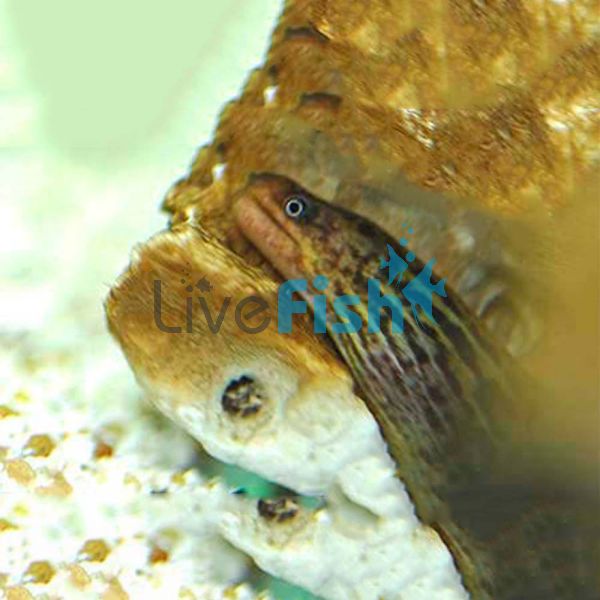Eel Freshwater Moray 15cm
The Freshwater Moray Eel is versatile regarding its habitat. It is commonly found in freshwater environments. But with proper acclimation, it can adapt to almost full-strength marine salinity.
Freshwater Moray Eel
The Freshwater Moray Eel has a pale brown/yellow body, covered with dark blotches and spots. Its teeth aren't as large as other species, but it can still give a nasty bite. Its saliva is toxic, although not to a dangerous level. There is a risk of infection if a wound isn't treated properly.
Evidence is starting to suggest that this is a catadromous species of Moray. Spending a large part of its life in freshwater but spawning in saltwater. Adults travel to the sea to breed, and youngsters are born in a marine environment. Juveniles are regularly seen in brackish water, hiding from predators in mangrove swamps. Adults are regularly observed in freshwater, but it is unknown at present how much time they spend there.
This species' native environment is in the Indo-Pacific area. Locations include Sri Lanka, Indonesia, Papua New Guinea, the Philippines, and Australia. They inhabit river mouths, estuaries, and shallow coastal areas to a depth of 3 meters (10 feet). It's possible for adults to grow to 1.5 meters (4.9 feet). However, the usual size is around 1 meter (3 feet).
Tank Recommendations for Freshwater Moray Eels
Freshwater Moray Eels need a tank with a capacity of at least 150 gallons (567 liters).
Morays need a secure cover on an aquarium to prevent an escape. Their skin is delicate and can get damaged by rough objects. So substrate should be sand or smooth gravel, with plenty of bigger rocks to provide shelter.
This species doesn't need a strong water flow. Studies in the wild have found they mostly inhabit still pools or areas with slow-flowing water. Freshwater Morays are adaptable to different water conditions. But the preferable environment seems to be brackish water with high salinity. Aquarists note that adding salt to water maintains health and appetite. A pure freshwater tank may reduce their appetite and lead to starvation.
Suitable Tank Buddies
Freshwater Morays are individualistic creatures and do not all share the same characteristics. Different specimens may react in a different way to certain fish. But they are aggressive and likely to consume smaller fish in a tank. A species-only aquarium is a more suitable option for an aquarium containing larger fish.
Usually Compatible
Housing with conspecifics is possible but works best if specimens are a similar size. Consider larger fish that aren't overly aggressive, and too big for the Moray to eat.
Sometime Compatible
Caution is advisable with Dwarf Angels, Anglers/Frogfish, Groupers, Hogfish, Parrots, and Wrasse
Rarely Compatible
Smaller fish such as Basslets, Blennies, and Clowns may be viewed as prey. Seahorses and Pipefish are too delicate. Also, avoid more aggressive species. Triggers or Sharks might outcompete them for food.
Feeding Your Freshwater Moray Eel
Freshwater Moray Eels are carnivorous. The main food in their diet is live fish and crustaceans. It may take a while to introduce them to prepared food such as shrimp, or fish pieces but it is possible. They usually only eat every 24 hours and being nocturnal are best fed in the evening. If Freshwater Morays are kept well fed it reduces the chance of them attacking other tank mates.
Feeding tongs can help protect aquarists from being bitten. Using them can also make it easier to wean them onto dead meat.
| Scientific Name | Gymnothorax polyuranodon |
|---|---|
| Care Level | Hard |
| Common Names | Freshwater Moray Eel, Many Toothed Moray, Spotted Freshwater Moray Eel, Blackspotted Moray, Tiger Freshwater Moray. |
| Diet | Carnivore |
| Fish Family | Muraenidae |
| Lifespan (years) | 10 |
| Max. Length (cm) | 150 |
| Min. Tank Volume (l) | 500 |
| Origin | Indo-Pacific - Sri Lanka, Indonesia, Papua New Guinea, Philippines, Australia |
| Reef Safe | No |
| Sociability | Aggressive |
| Venomous | Yes |
| Water Conditions | Brackish with medium to high salinity 24 -28°C (75.2-82.4° F), dKH 8-12, pH 7.0-8.2, sg 1.008-1.012 |




